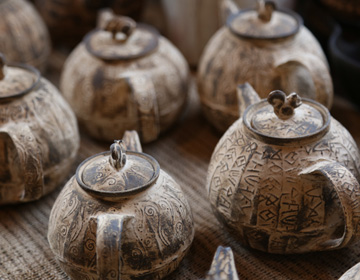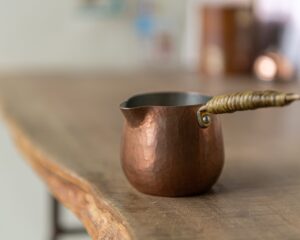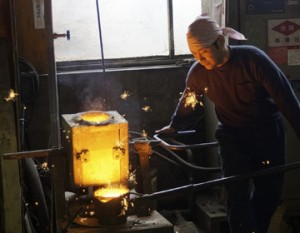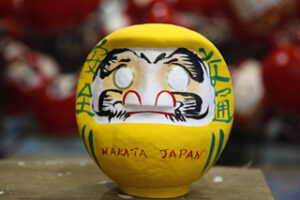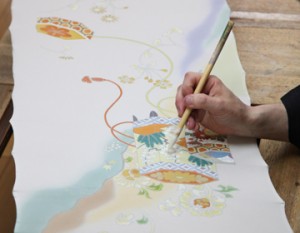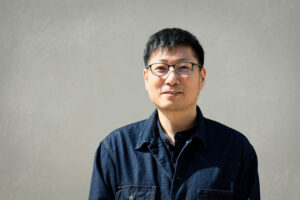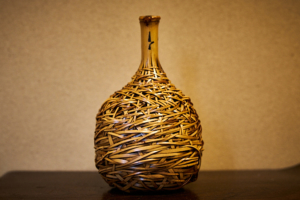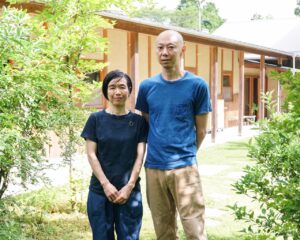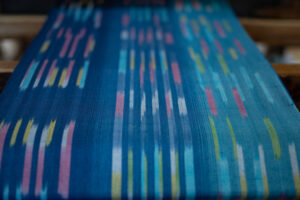Kisarigeki Kiln is a pottery kiln that uses materials mainly from within Iwate Prefecture to create pottery that brings out the best of the materials.
Using a variety of techniques, they skillfully express the beauty of the Iwate region in their pottery. The warmth and strength of the clay and the ease of use in everyday life make their pottery a must-see.
A studio that produces warmth
Morioka City is located in the center of Iwate Prefecture. The Takamatsu Pond there is known as a swan flying site. Yuichi Yukinoura’s pottery studio, Kisaragi Kiln, is located on a hill adjacent to the pond. Mr. Yukinoura studied mathematics in the Faculty of Education at Iwate University, but majored in art as a minor. He studied classical painting, including frescoes, and after graduating from the mathematics department, he took a special art course and studied pottery in Nopporo, Hokkaido.
When Nakata commented on the “softness” of the tableware and other pieces lined up in the studio, Yukinoura said, “I am often told that they are warm. Indeed, the works on the shelves all have a simple warmth that comes from the relaxed nature of the clay. Yukinoura creates such tableware every day, which would be comforting to have on one’s dining table.

Using Local Products from Iwate
The dishes are only as good as the people who use them, ” says Yukinoura. I think it’s no good if you can’t make everyday tableware,” he says. Although he sometimes creates so-called “works of art” for exhibitions, at the core of his work is his commitment to making everyday vessels. This feeling can be sensed in the fact that he creates dishes that are not only stylish in appearance, but also easy to use.
Yukinoura also makes ceramics using as much as possible materials from Iwate, such as soil and ash. Most of his pottery is made of clay from Tono, Hanamaki, and Shiwa, but he also blends in a little fire-resistant Shigaraki clay for strength. He also uses apple ash to create a unique texture by layering the ash glaze over and over again in varying proportions to give it a glass-like thickness. Lacquer is also used as a glaze for ceramics. The surface of the finished piece is then lacquered with lacquer to prevent it from absorbing moisture during use.
He searches for materials in the wide area of Iwate Prefecture and always enjoys variations of clay. He is constantly experimenting with how to make the most of its completely different expressions.

Nakata is also fascinated by the pottery experience.
Yukinoura-san uses a variety of techniques, including rokuro (potter’s wheel), hand-building, and mold making, but this time, he allowed us to try our hand at making pottery using the tatara technique. The tatara technique is a method of forming a sheet of dough into a shape. It is a different and more difficult process than using a potter’s wheel, where a lump of clay is formed into a shape.
The shape must be changed slowly and gradually during the molding process, or else it will become distorted. Also, if the force applied for shaping is not uniform, tempering will occur during the firing process, which is another cause of deformation.
Nakata also took advice on how to shape the pieces little by little. He found himself so absorbed in the process that he ended up making two bowls and even a flat plate. Once the molding is done, the final step is to put a pattern on it and it is done. We are looking forward to seeing the finished product.
Ms. Yukinoura is trying to convey the simple and warm presence of clay that we have almost forgotten through her works. The design of his tableware, coupled with his desire to convey this warmth, will become a part of our daily lives.
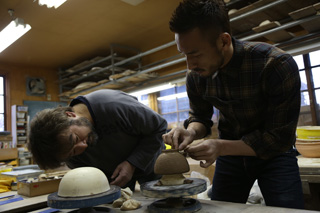

I work hard every day, hoping that the works of Kisaragi Kiln will enrich the lives of those who use them. I hope that my works will enrich the lives of people who use them.



